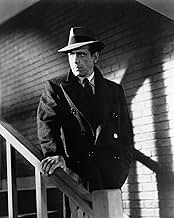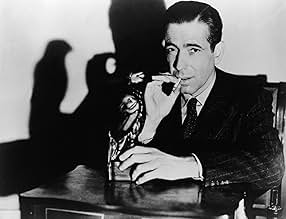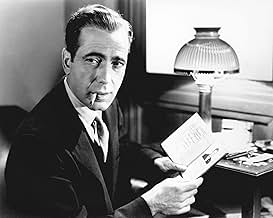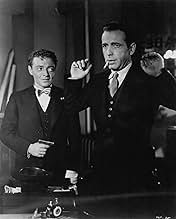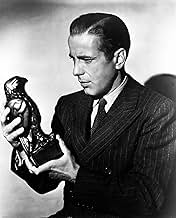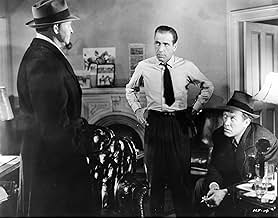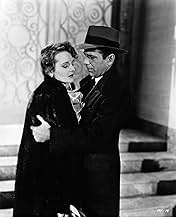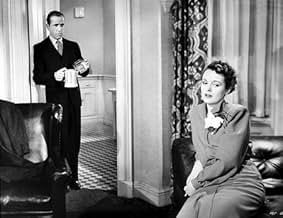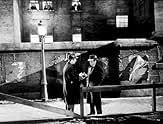Um detetive particular assume um caso que o envolve com três criminosos excêntricos, um magnífico mentiroso e sua busca por uma estatueta incomparável.Um detetive particular assume um caso que o envolve com três criminosos excêntricos, um magnífico mentiroso e sua busca por uma estatueta incomparável.Um detetive particular assume um caso que o envolve com três criminosos excêntricos, um magnífico mentiroso e sua busca por uma estatueta incomparável.
- Direção
- Roteiristas
- Artistas
- Indicado a 3 Oscars
- 8 vitórias e 4 indicações no total
Charles Drake
- Reporter
- (não creditado)
Chester Gan
- Bit Part
- (não creditado)
Creighton Hale
- Stenographer
- (não creditado)
Robert Homans
- Policeman
- (não creditado)
William Hopper
- Reporter
- (não creditado)
- Direção
- Roteiristas
- Elenco e equipe completos
- Produção, bilheteria e muito mais no IMDbPro
Avaliações em destaque
Seven decades have passed but the suspense and thrill of The Maltese Falcon still reign supreme. The movie, despite being in black & white, appears strikingly refreshing both to the eyes and the intellect. Primarily remembered as John Huston's directorial debut, the movie played a decisive role in giving Film-Noire its true identity as a genre. The Maltese Falcon also gave Humphrey Bogart his highly deserved super-stardom that had hitherto eluded him. Huston creates an environment of suspicion, doubt and uncertainty that is so convoluted that even Hitchcock would be proud of it. The movie has multiple layers of mystery and suspense that keeps the viewer engaged throughout.
Sam Spade is a private detective who runs an agency with his partner Miles Archer. An ostensibly naive lady, Miss Wanderly offers them a task to pursue a man, Floyd Thursby, who has allegedly run off with her younger sister. The over-simplicity of task arouses Spade's suspicion, but Wanderly's lucrative offer makes the duo overlook it initially. Miles is killed during the pursuit and the police inform Spade of the mishap. Spade only discreetly tells the police that Miles was after a man named Thursby without disclosing anything about Miss Wandely. The police soon find Thursby dead as well and suspect Spade for killing him in an act of revenge. Soon Miles Archer's widow shows up at Spade's office and insinuates of her romantic involvement with Spade, who shuns her away after she tries to incriminate him for the murder. The police come across an anonymous lead and begin suspecting Spade for killing his partner, Miles. The plot thickens with the entry a couple of obscure characters including Joel Cairo, who happens be an acquaintance of Miss Wanderly. He is in pursuit of a highly precious, antique, gold statuette of Maltese Falcon and offers Spade five grands to help him find it. A game of cat and mouse soon ensues, between the various stake holders, which becomes deadlier as the stakes are raised.
Humphrey Bogart perfectly fits into the shoes of Spade—a sleek and sharp sleuth—and makes it his own in a manner that only someone of his grit and caliber could. Bogart is in top form right from the inception to the finale, stealing the spotlight in almost every scene that is he is part of. Bogart could only demonstrate his prodigious talent and acting prowess in short bursts during his long "B movie" stint in which he was mostly type-casted as a gangster. The Maltese Falcon was Bogart's big break after years of anticipation and he didn't leave a single stone unturned to prove his mettle. Bogart shows his class and stamps his authority as a performer during the portrayal of Spade: he is ever so quick-witted thanks to his sublime articulacy and his prowess at repartee seems unparalleled; the inherent cynicism in Spade and the perspicacity with which he operates soon became Bogart's trademark and catapulted him to super-stardom. Many regard Bogart's performance in Casablanca as his absolute best, but I rate his portrayal of Spade second only to his supernal portrayal of Dobbs in The Treasure of Sierre Madre, where he took acting to hitherto unattainable and unforeseeable heights.
John Huston uses the Midas touch he had as a screenwriter to strike all the right cords in his directorial debut. Almost everyone in the supporting cast gives a memorable performance with special mention of Peter Lorre as the deceptive Joel Cairo, Sydney Greenstreet as the witty yet dangerous Kasper Gutman and Mary Astor as the scheming Brigid O' Shaughnessy. The taut plot of the movie, which is masterfully adapted from the novel of the same name by Huston himself, is well complemented by the impressively written dialogs that are delivered with an equal prowess. Amidst the everlasting suspense the movie has an obvious undertone of dark humor that adds great value to the movie. The cinematography undoubtedly features amongst the best works of the time.
The Maltese Falcon is not merely a Noire masterpiece but also a testament to the true spirit of cinema that has kept itself alive despite decades of relentless mutilation and sabotage in the name of commercial movie-making. Despite being devoid of modern-day gimmicks the movie is incredibly high on suspense and holds the viewer in a vice-like grip throughout its runtime. It's a real shame that movies like these are seldom made these days. The tone of the movie is such that it makes suspense thrillers of today appear like kids cartoon.
PS. The movie is an ode to Bogart, Huston and all those who made it a reality. It's suspense cinema at its absolute best with a completely different treatment to themes propagated by the likes of Hitchcock. It's a must for all the Bogart fans worldwide, and absolutely essential for all those who have a penchant for Film-Noire as a genre. 10/10
http://www.apotpourriofvestiges.com/
Sam Spade is a private detective who runs an agency with his partner Miles Archer. An ostensibly naive lady, Miss Wanderly offers them a task to pursue a man, Floyd Thursby, who has allegedly run off with her younger sister. The over-simplicity of task arouses Spade's suspicion, but Wanderly's lucrative offer makes the duo overlook it initially. Miles is killed during the pursuit and the police inform Spade of the mishap. Spade only discreetly tells the police that Miles was after a man named Thursby without disclosing anything about Miss Wandely. The police soon find Thursby dead as well and suspect Spade for killing him in an act of revenge. Soon Miles Archer's widow shows up at Spade's office and insinuates of her romantic involvement with Spade, who shuns her away after she tries to incriminate him for the murder. The police come across an anonymous lead and begin suspecting Spade for killing his partner, Miles. The plot thickens with the entry a couple of obscure characters including Joel Cairo, who happens be an acquaintance of Miss Wanderly. He is in pursuit of a highly precious, antique, gold statuette of Maltese Falcon and offers Spade five grands to help him find it. A game of cat and mouse soon ensues, between the various stake holders, which becomes deadlier as the stakes are raised.
Humphrey Bogart perfectly fits into the shoes of Spade—a sleek and sharp sleuth—and makes it his own in a manner that only someone of his grit and caliber could. Bogart is in top form right from the inception to the finale, stealing the spotlight in almost every scene that is he is part of. Bogart could only demonstrate his prodigious talent and acting prowess in short bursts during his long "B movie" stint in which he was mostly type-casted as a gangster. The Maltese Falcon was Bogart's big break after years of anticipation and he didn't leave a single stone unturned to prove his mettle. Bogart shows his class and stamps his authority as a performer during the portrayal of Spade: he is ever so quick-witted thanks to his sublime articulacy and his prowess at repartee seems unparalleled; the inherent cynicism in Spade and the perspicacity with which he operates soon became Bogart's trademark and catapulted him to super-stardom. Many regard Bogart's performance in Casablanca as his absolute best, but I rate his portrayal of Spade second only to his supernal portrayal of Dobbs in The Treasure of Sierre Madre, where he took acting to hitherto unattainable and unforeseeable heights.
John Huston uses the Midas touch he had as a screenwriter to strike all the right cords in his directorial debut. Almost everyone in the supporting cast gives a memorable performance with special mention of Peter Lorre as the deceptive Joel Cairo, Sydney Greenstreet as the witty yet dangerous Kasper Gutman and Mary Astor as the scheming Brigid O' Shaughnessy. The taut plot of the movie, which is masterfully adapted from the novel of the same name by Huston himself, is well complemented by the impressively written dialogs that are delivered with an equal prowess. Amidst the everlasting suspense the movie has an obvious undertone of dark humor that adds great value to the movie. The cinematography undoubtedly features amongst the best works of the time.
The Maltese Falcon is not merely a Noire masterpiece but also a testament to the true spirit of cinema that has kept itself alive despite decades of relentless mutilation and sabotage in the name of commercial movie-making. Despite being devoid of modern-day gimmicks the movie is incredibly high on suspense and holds the viewer in a vice-like grip throughout its runtime. It's a real shame that movies like these are seldom made these days. The tone of the movie is such that it makes suspense thrillers of today appear like kids cartoon.
PS. The movie is an ode to Bogart, Huston and all those who made it a reality. It's suspense cinema at its absolute best with a completely different treatment to themes propagated by the likes of Hitchcock. It's a must for all the Bogart fans worldwide, and absolutely essential for all those who have a penchant for Film-Noire as a genre. 10/10
http://www.apotpourriofvestiges.com/
Humphrey Bogart died nearly fifty years ago, but polls still put him at the top of all-time Hollywood stars. What turns a man into a legend? The man himself wasn't much: a slight build, not too tall, no Stallone muscles to swell his suit. What he had in classic films like `The Maltese Falcon' was a voice that cut through a script like a knife. `The Maltese Falcon,' directed by John Huston in 1941, reprised Dashiell Hammett's thriller. (It had been filmed before.) Hammett practically invented the tough guy so deep in cynicism nobody could hope to put anything past him. The novel, thick with plot, wasn't easy for director John Huston to untangle. Few people who cherish this film can summarize its story in a sentence or two. I'll try. San Francisco private eye Sam Spade (Bogart) is pulled into the search for a fabulously valuable statue by a woman who seeks his help. First, his partner is killed, then Spade pushes through her lies to uncover connections to an effete foreigner (Peter Lorre) and a mysterious kingpin (Sydney Greenstreet). The story unfolds like a crumpled paper. But the whodunit becomes less important than how we respond to the strong screen presence of Bogart and his co-stars. That's what makes `The Maltese Falcon' a classic. We see more and appreciate more each time we watch it. The art of Huston and Bogart doesn't come across until a second or third viewing. Huston invented what the French called film noir, in honor of Hollywood films (often `B' movies, cheap to make, second movies in double features) that took no-name stars into city streets to pit tough guys, often with a vulnerable streak, against dangerous dames. Audiences knew that when the tough guy said, `I'm wise to you, babe,' he'd be dead within a reel or two. Bogart was luckier than most noir heroes, but it cost. Struggling to maintain his own independence against the claims of love or his own penchant towards dishonesty the Bogart hero can do little better than surrender, with a rueful shrug, to the irony his survival depends on. The climax of `The Maltese Falcon' ranks with the last scene of `Casablanca,' another Bogart vehicle, in showing how the tough guy has to put himself back together after his emotions almost get the better of him. That assertion of strength, bowed but not broken, defines the enduring quality of Bogart on screen. For Huston, telling this story posed a different problem. Telling it straight wasn't possible too many twists. Huston chose to focus on characters. One way to appreciate Huston's choices is to LISTEN to the movie. Hear the voices. Notice how in long sequences narrating back story, Huston relies on the exotic accents of his characters to keep us interested. Could we endure the scene in which Greenstreet explains the history of the Maltese falcon unless his clipped, somewhat prissy English accent held our attention? Also, we watch Bogart slip into drug-induced sleep while Greenstreet drones on. Has any director thought of a better way to keep us interested during a long narrative interlude? And is there a bit of wit in our watching Bogart nod off during a scene which, if told straight, would make US doze? All of this leads to the ending, minutes of screen time in which more goes on, gesture by gesture, than a million words could summarize. He loves her, maybe, but he won't be a sucker. The cops come in, and the emotional color shifts to gray, the color of film noir heroes like Bogart. Bars on the elevator door as Brigid descends in police custody foreshadow her fate in the last image of Huston's film. But after the film, we're left with Spade, whom we like and loathe, a man whose sense of justice squares, just this once, with our own, maybe. Black and white morality prevails in a black and white movie, but Sam Spade remains gray and so does our response to this film classic.
Sam Spade and Miles Archer are detectives, the private type who you can give directives, after meeting with a dame, there then begins a deadly game, with a group who seem to have, their own perspectives; although they all have as their goal a missing falcon, and soon there are some folks, who find their souls gone, as beneath the dark veneer, there are those quite insincere, as you'll find after a number of liaisons; as the story ratchets up the threads combine, and at the centre of the plot's a large waistline, that speaks with eloquence and intent, as deep within, passions ferment, in a film that is a classic of its time.
Great cast, great story, great film - but isn't Sydney Greenstreet outstanding!
Great cast, great story, great film - but isn't Sydney Greenstreet outstanding!
"The Maltese Falcon", scripted and directed by Hollywood first-timer John Huston (from Dashiell Hammett's novel), would go on to become an American film classic. Humphrey Bogart chews the scenery in his star-making turn as acid-tongued private eye Sam Spade, whose association with the beautiful and aloof Brigid O'Shaughnessy (Mary Astor), neurotic Joel Cairo (Peter Lorre), and morbidly obese Kasper Gutman (Sydney Greenstreet, in his Oscar-nominated screen debut) over the recovery of the title object, sets in motion a movie experience that is as much crackling as it is dazzling. While much of the action and dialogue is considerably dated by modern standards, the film's essential power to mystify and entrance remains undiminished despite its age. While this was the third adaptation of Hammett's story (the first was made in 1931 and the second was "Satan Met a Lady" (1936)), this is also the best remembered and most praised, due largely in part to Bogart's seemingly effortless portrayal of the tough but softhearted, world-weary hero. Mary Astor and Lee Patrick were, respectively, the definitive femme fatale and girl Friday, and the villianous roles of Cairo, Gutman and Wilmer (Elisha Cook Jr.) were equally remarkable. What may not be wholly obvious is the fact that these three men have homosexual tendencies (as given in the novel), but just look at what's given: Cairo's delicate speech and manner, Wilmer's questionable quick tempered attitude towards Spade (could this be covering up the fact that he finds Spade attractive?) and Gutman's clutching of Spade's arm when Sam arrives at his hotel room. A polished film noir that gave rise to Bogart's mounting popularity. (Sidenote: The character of Sam Spade was originally offered to George Raft, who turned it down. Raft also turned down "Casablanca" (1942), "High Sierra" (1941) and William Wyler's "Dead End" (1937), all of which went to Bogart and helped to boost his star status. Bogart had Raft to thank for his enduring popularity.) A must-see masterpiece. ****
If not, it's pretty damn close. My husband and I are different than most because instead of just looking for movies we tend to find actors we love and then watch all of their movies. We're fans of the star first and then the movie second. Humphrey Bogart had it all. He was authentic, compelling, and could convey so many emotions with just a twinkle or a tinge of doubt, or suspicion, or fear, or lust, or greed, whatever it was he had to convey, he did it with full conviction. If there's a better movie star that ever lived, I can't name them. There may be actors with more range, but not better movie stars. I think actors can be great even if they don't transform as Day-Lewis does. Don't get me wrong, Day-Lewis is a genius, but an actor who is completely authentic and compelling (something going on underneath) is just as interesting to watch as an actor who transforms themselves.
Você sabia?
- CuriosidadesThree of the falcon statuettes made for the production still exist and are conservatively valued at over $1 million each. This makes them some of the most valuable film props ever made; indeed, each is now worth more than three times what the film cost to make.
- Erros de gravaçãoWhen Spade backslaps Cairo, and Peter Lorre's head snaps to the left, he's wearing a polka dot bow tie, but when his head snaps back to the right, his cravat has become striped.
- Citações
Joel Cairo: You always have a very smooth explanation ready.
Sam Spade: What do you want me to do, learn to stutter?
- Versões alternativasAlso available in a computer colorized version.
- ConexõesEdited into Contos da Cripta: You, Murderer (1995)
Principais escolhas
Faça login para avaliar e ver a lista de recomendações personalizadas
Detalhes
- Data de lançamento
- País de origem
- Idioma
- Também conhecido como
- Relíquia Macabra
- Locações de filme
- Bush Street, San Francisco, Califórnia, EUA(death of Miles Archer)
- Empresa de produção
- Consulte mais créditos da empresa na IMDbPro
Bilheteria
- Orçamento
- US$ 375.000 (estimativa)
- Faturamento bruto nos EUA e Canadá
- US$ 18.180
- Faturamento bruto mundial
- US$ 41.740
- Tempo de duração
- 1 h 40 min(100 min)
- Cor
- Proporção
- 1.37 : 1
Contribua para esta página
Sugerir uma alteração ou adicionar conteúdo ausente



